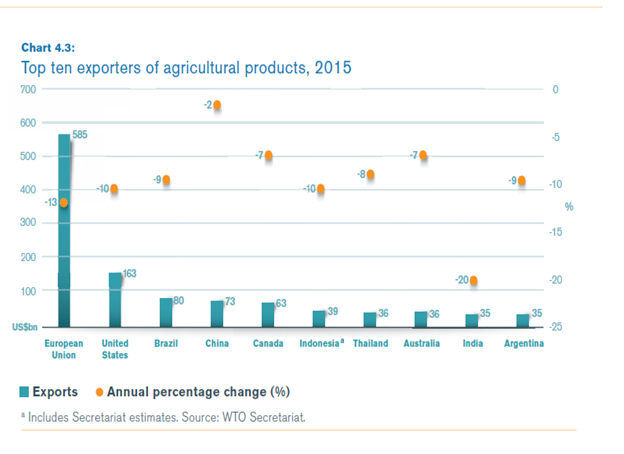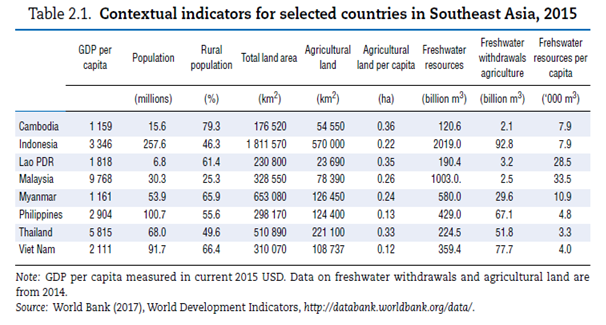
Agriculture is still an important sector in national economic development. Agriculture has several important roles for Indonesia. The role of agriculture are provision of food and industrial raw materials, contributors to GDP, foreign exchange earners, labor absorption, the main source of rural household income, feed and bioenergy providers, and a role in reducing greenhouse gas emissions (RENSTRA KEMENTAN 2015-2019).
Sudaryanto (2006) in their research stated that the agricultural sector, especially wetland farming business has a large multifunctional value in improving food security, farmer welfare, and preserving the environment. In addition, Rivai (2011) also analyzed the role of agricultural development for the national economy. The strategic role of the agricultural sector is shown by its role in capital formation, food supply, industrial raw materials, feed and bioenergy, employment absorber, source of foreign exchange and income sources, and environmental conservation through environmentally friendly farming practices.
Agriculture has been quite well developed in providing adequate food for Indonesian. For example, rice. According to data from Kementerian Pertanian, rice production increased by 11.7% from 2014 to 2016. Total rice production in 2014 amounted to 70,846,465 tons. The number has increased until in 2016 the number reached 79,141,352 tons. Meanwhile, for other commodities such as shallots, corn, and chilies also increased. Shallots increased by 3.76%, corn by 21.8%, and chilies by 1.81%. By 2015, imports of shallots have decreased by 77%. In 2016, imports of corn decreased by 60% This increase in production is a hope for the development of agriculture in Indonesia. With increasing production, production will be sufficient to meet domestic demand so that it does not depend on imports. Kementerian Pertanian has even targeted Indonesia as a world food barn in 2045. After the production of rice, shallots, and chilies have increased, Kementerian Pertanian is autologous for subsequent years of increase will occur in other commodities. By 2017, an increase is expected to occur in corn. Year 2019, is expected to occur in sugar. Until the year 2033 Kementerian Pertanian is optimistic there will be increased production in garlic. Thus, in 2045 Kementerian Pertanian targets Indonesia to become a world food barn.
Agriculture is also a sector that contributes considerably to the Indonesian economy. GDP value of agriculture, forestry, and fishery sector in the period 2012-2016 always increased. In 2012, the value is 1.039.441 billion rupiahs, in 2013 of 1.083.142 billion rupiahs, 2014 of 1.129.053 billion rupiahs, 2015 of 1.171.579 billion rupiahs, and in 2016 its value reached 1.209.687 billion rupiahs.
 Agriculture in Indonesia is not only used to meet domestic food needs but also has enough to meet the needs of other countries. The table above shows that Indonesia is among the top ten exporting countries of agricultural products by 2015. The export value of Indonesian agricultural products in 2015 amounted to 39 billion US $. This value occupies the position of 6 out of 10 countries. Meanwhile, the percentage of annual change reaches -10%. The highest position is occupied by the European Union with a value of 585 billion US $. While the lowest position is occupied by Argentina with a value of 35 billion US $. The increase in export value will improve the Indonesian economy as measured by GDP value because exports are one of the main components of GDP according to the expenditure approach.
Agriculture in Indonesia is not only used to meet domestic food needs but also has enough to meet the needs of other countries. The table above shows that Indonesia is among the top ten exporting countries of agricultural products by 2015. The export value of Indonesian agricultural products in 2015 amounted to 39 billion US $. This value occupies the position of 6 out of 10 countries. Meanwhile, the percentage of annual change reaches -10%. The highest position is occupied by the European Union with a value of 585 billion US $. While the lowest position is occupied by Argentina with a value of 35 billion US $. The increase in export value will improve the Indonesian economy as measured by GDP value because exports are one of the main components of GDP according to the expenditure approach.
 The use of agricultural land in Southeast Asia has increased by around 40% during 1980 to 2014. The most significant increase has occurred in Indonesia, which has the largest total land area (OECD-FAO Agricultural Outlook, 2017). Indonesia has a large enough land, freshwater withdrawal agriculture is quite abundant. The table above states that Indonesia has a total land area of 1.811.570 km2. While the area of agricultural land of 570.000 km2. Its land is the largest in Southeast Asia. Meanwhile, freshwater resources in Indonesia in 2015 amounted to 2019.0 billion m2. Freshwater withdrawal agriculture of 92,8 billion m2. With all the natural resources that have been owned, agriculture is very potential to be developed in Indonesia.
The use of agricultural land in Southeast Asia has increased by around 40% during 1980 to 2014. The most significant increase has occurred in Indonesia, which has the largest total land area (OECD-FAO Agricultural Outlook, 2017). Indonesia has a large enough land, freshwater withdrawal agriculture is quite abundant. The table above states that Indonesia has a total land area of 1.811.570 km2. While the area of agricultural land of 570.000 km2. Its land is the largest in Southeast Asia. Meanwhile, freshwater resources in Indonesia in 2015 amounted to 2019.0 billion m2. Freshwater withdrawal agriculture of 92,8 billion m2. With all the natural resources that have been owned, agriculture is very potential to be developed in Indonesia.
Agriculture is a very potential sector to be developed. But there are still many problems that occur in agriculture in Indonesia. Winoto (2008) in their research stated that agricultural problems that occur in Indonesia include low agricultural growth, poverty and rural development are relatively stagnant, agriculture is still concentrated in Java, threats of food security, land degradation and the threat of water sustainability and energy security.
The main problem that occurs in agriculture is the conversion of agricultural land. The rate of conversion of productive agricultural land to the use of non-agricultural sectors continues to increase. The rate of conversion of paddy fields reaches 100 thousand hectares per year. Conversion of paddy fields about 80% occurred in the national food production center area of Java Island. This has an impact on Indonesia's food security (RENSTRA KEMENTAN 2015-2019). The impact of wet land conversion has also been analyzed in other studies. Irawan (2005) in his research stated that the conversion of wetland to non-agricultural use has negative economic, social and environmental impacts. In addition to land conversion, the land has also declined in quality. The use of inorganic fertilizers and chemicals in excess causing soil structure to solidify and the carrying capacity for plant growth decreases.
In addition to the issue of conversion of agricultural land is very high. Another problems that occurs are the land is concentrated in Java Island and infrastructure. Land and irrigation issues are one of the root causes of welfare problems. Java Island in addition to having many inhabitants also has extensive farmland. According to data from Statistik Lahan Pertanian 2010-2014 published by the Kementerian Pertanian, the area of rice fields is dominated by Java Island, especially East Java Province. East Java province has the largest rice field during 2010-2014 compared with other provinces. Area of rice field of East Java Province in 2014 amounted to 1,101,765.00 Ha. Meanwhile, the area of wetland in the province outside Java is relatively smaller. For example, Aceh Province has a land area of 294,129.00 Ha. Extensive land is the main production factor for farmers. Java Island, especially East Java Province which has wide land is expected to produce agricultural products with optimal. However, it turns out that the vast land has not been supported by optimal infratructure improvement. For example East Java Province. East Java province still has some irrigation infrastructure problems. East Java Governor Soekarwo said various problems related to irrigation infrastructure, including 470 irrigation dams, irrigation management that has not been integrated, and irrigated rice fields that failed to harvest due to routine floods of 30 thousand hectares.
Graph of Agricultural, Forestry, and Fishery Growth Rates at Constant Prices
for 2012-2016
Base Year 2010

Source: Badan Pusat Statistik (2016)
Another problem that occurs is the growth rate of the agricultural sector which is relatively decreased from year to year. The growth rate of agriculture, forestry, and fishery sector decreased from 4,59 to 3,25 in 2016. The weakening of agricultural sector growth can be seen from several indicators, namely the role of the agricultural sector to the industrial sector, the area of wet land ownership, and Farmers' Farm Exchange (Bank Indonesia 2007).
Agriculture has an important role for Indonesia. Not only improve welfare through the provision of food sufficiency, but agriculture is also one of the sectors that have the potential to improve the Indonesian economy. Agriculture has become one of the sectors that have GDP which always increase from year to year. In addition, Indonesia is also included in the top ten exporting countries of agricultural products in Indonesia. This is a good hope for Indonesian agriculture because Indonesia is also supported by extensive farmland. However, there are still many problems that occur such as land conversion, land concentration in Java and infrastructure, and the growth of agriculture sector is getting weaker. There needs to be some policy that must be done to overcome the problem. The government should be able to reduce the rate of land conversion by strictly enforcing land use rules so that agricultural land will not narrow. There should be efforts to improve the infrastructure to optimally utilize the potential of the land. In addition, government policy in controlling the price of agricultural products is very important in determining farmers' income.